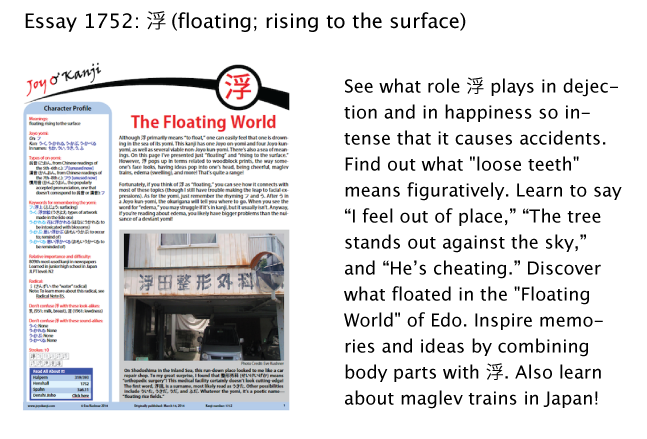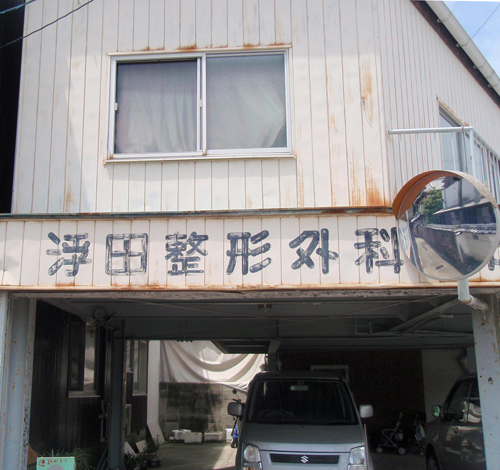By the Numbers
Let's start with a quiz—actually Quiz #1 of 2. An official list of Joyo kanji and Joyo yomi contains the following sentence, which explains how that document handles ateji. What do you think the red word means?
便宜上,その読み方を平仮名で示し,五十音順に並べた。
We presented their yomi in hiragana for convenience and sorted them in the _____.
便宜上 (べんぎじょう: for convenience); 読み方 (よみかた: way of reading; how to read); 平仮名 (ひらがな: hiragana); 示す (しめす: to present, display); 五十音順 (ごじゅうおんじゅん: ____); 並べる (ならべる: to sort)
I'll block the answer with a preview of the new essay, which is on 浮 (floating; rising to the surface):

By the way, here's a bigger picture of the image on the cover.

Photo Credit: Eve Kushner
Quiz #2: What kind of business do you think this is? The answer will come at the end of this blog post.
Back to the sentence about ateji, here's the answer:
五十音順 (ごじゅうおんじゅん) means "the syllabary order" or "order of the kana syllabary."
Therefore, the full sentence is "We presented their yomi in hiragana for convenience and sorted them in the order of the kana syllabary."
English speakers might explain "alphabetical order" by referring to an A-B-C sequence, but in Japanese, the way to represent "syllabary order" is with numbers!
The word 五十音順 breaks down as follows:
五十音順 50 (1st 2 kanji) + sounds + order
Wait, are there actually 50 kana? No! As Wikipedia explains, the name 五十音 comes from the 5x10 grid used to display the kana—a grid that is not completely filled. There are now just 46 kana. Of these, 2 are obsolete. Nevertheless, the old name holds fast, probably because 50 is a nice round number, though 五十 doesn't look particularly "round," just as MCXXXIX doesn't!
Numbers keep popping up in unexpected places lately. For two nights straight, my dinner conversations with my engineer-husband have turned to math. This evening over Indian food we idly chatted about algorithms (and how they differ from equations), matrices (and their purposes), and symmetrical shapes around the y-axis.
We broached that last topic because when I wrote an essay on 偶 (by chance; spouse; even number; idol) this week, I encountered 偶関数 (ぐうかんすう: function whose graph has symmetry about the y-axis) and reluctantly decided not to include it. (You probably don't need to know it, right?) But when I was telling him about it, I couldn't remember where I had seen this term and therefore which kanji it included. Racking my brain, I figured that I must have spotted it when I researched 髪, hair. He agreed that that made sense because a graph with symmetry around the y-axis could look like a woman's head if her hair were long.
Anyway, I found the whole talk quite stimulating, as it brought up long-forgotten ways of thinking. In fact, I used to love math, and I think there's something beautifully mathematical about kanji. After all, aren't we mainly finding and enjoying patterns?
Even if you hate math, I hope you can hang in there as we explore number kanji and all the surprises they offer. I won't ask you to do any calculations!
Take, for instance, this place name:
四万十川 (しまんとがわ: Shimanto River in Kochi Prefecture)
40,010 (1st 3 kanji) + river
It's considered one of the most beautiful and clearest rivers in Japan. It's also famous for its 47 "sinking bridges" (沈下橋, ちんかばし). Built close to the water to keep costs low, the bridges have no parapets, which helps to prevent them from being washed away in floods.

Photo Credit: 京浜にけ
When my language partner Kensuke-san told me he had been there on vacation, he had plenty to say. He described the bridges and the beauty of the place. He also explained that he had traveled all the way from Tokyo to Kochi Prefecture on Shikoku to see the river, staying just one night and then returning to Tokyo for work. On top of that, he was feeling quite ill at the time. All of this was interesting, but the name tugged at me, and I couldn't let it go. Why does the river name consist entirely of numbers?
After some quick research, he explained that there are several theories about this, one being that the river has 40,010 (四万十) tributaries. I can't even begin to conceive of that!
As long as we're talking about nature, I'll share another number-related term I've encountered:
四方山話 (よもやまばなし: talk about various topics) 4 + directions + mountains + talk
If a conversation goes in all directions, it's as if people have directed their attention to the mountains in all four directions! That gives new meaning to the expression "wide-ranging talk"!
The etymology site Gogen notes that the yomi of よもやま (what a tongue-twister!) probably came from よもやも (even harder to say!), which had several possible kanji renderings: 四方八方, 四面八面, and 四表八表. Each term meant "all directions."
Well, this conversation seems to have gone in all directions. Even though I still have more number-rich terms to share with you, I should probably stop here. I'll finish up next time. However, over the week my list of fun numerical terms may keep multiplying so that it becomes mathematically impossible ever to complete the discussion!
Oh, before I go, I owe you an answer to Quiz #2, which was about the run-down business with a sign saying 浮田整形外科. That establishment on the island of Shodoshima in the Inland Sea looked to me like a car repair shop. To my great surprise, I found that 整形外科 (せいけいげか) means “orthopedic surgery”! This medical facility certainly doesn’t look cutting-edge, so to speak! (By the way, the first word, 浮田, is a surname, most likely read as うきた.)
Although Breen indicates that 整形外科 can also mean "plastic surgery," that isn't true until one precedes this term with 美容 (びよう: beauty). You may know this word from 美容院 (びよういん: beauty salon). Anyway, this tells us that plastic surgery is a type of orthopedic surgery that makes you beautiful!
Have a great weekend!

Comments